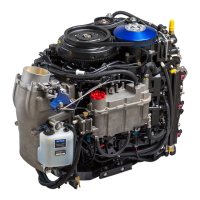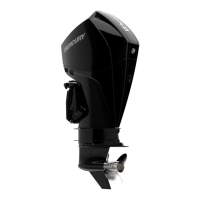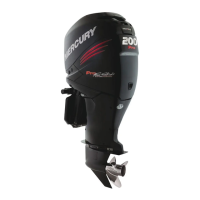To determine the current equivalence ratio, an oxygen sensor measures the exhaust and compares its oxygen content to the
ideal oxygen content. The equivalence ratio is also referred to by the Greek letter phi (pronounced fee).
In this CDS G3 screen capture, the engine has entered closed-loop control. It is targeting a phi (equivalency ratio) of 1.1484.
It is reading a phi of 1.14 and adjusting port fuel trim (02Control_Iterm_Port) by 1.86%.
At times, such as when the engine is first started, the PCM may target a higher phi (run richer than stoichiometric) to allow easy
starting and better run quality when the engine is cold.
Oxygen (O2) Sensor
The PCM uses a single oxygen sensor to measure the amount of hydrocarbons and oxides of nitrogen in the exhaust. If there
are excess hydrocarbons (unburned fuel), the air/fuel ratio is too rich. If there are too many oxides of nitrogen, the mixture is to
lean. The PCM can use these measurements to add or subtract fuel by changing the time the fuel injectors are open.
The PCM 112's O2 sensor is referred to as UEGO1 (universal exhaust gas oxygen), and S1 in CDS G3.
O2 sensor displays on a CDS G3 Live Data screen
The O2 sensor temperature and heater duty cycle
This sensor operates around 768–791 °C (1416–1456 °F). Maintaining the proper temperature is vital to precise measurement.
The O2 sensor reaches temperature very quickly, usually within 10 seconds. The heater duty cycle can range from 0 to 100%,
but typical values are 15–40% at idle. If a problem is suspected with the heater or sensor, the only diagnostic test is to replace it
with a known good sensor and see if it reacts similarly.
Do not attempt to tap into or splice into the O2 sensor wires. It is more expedient and cost effective to replace the sensor if it
has failed.
Open‑Loop and Closed‑Loop Operation
When the PCM is monitoring the exhaust and adjusting the fuel, it is considered to be in closed‑loop operation. An excess of
hydrocarbons or oxides of nitrogen have important ramifications for air quality and are the subject of emissions control
regulations.
The PCM 112 stays in closed‑loop control throughout the power ranges, except for brief moments when the engine starts or
transitions from power settings.
System Theory
90-8M0146617 eng JULY 2018 © 2018 Mercury Marine Page 1B-3

